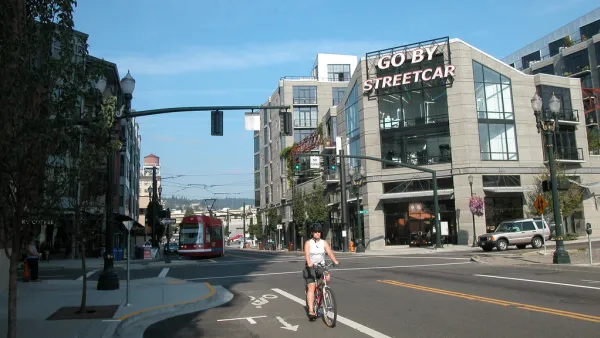Portland's over-educated, under-employed population is largely a semi-retired community of young adults, according to some. But with rising housing prices and overall cost of living, it is unclear how Portland will retain these characteristics.
As Claire Cain Miller writes for a recent piece in the New York Times Magazine, Portland's future as an urban utopia for kombucha brewers, kale growers, and households living off barista tips is hazy. The city has a high amount of educated residents, and unlike corporate nearby cities like San Francisco or Seattle, Portland offers few high-level employment opportunities for them, leading many young people to enter semi-retirement.
According to a July report by the Oregon Employment Department, the state is concerned with low personal income levels, coupled with its employment-to-population ratio. As Miller highlights, "the average income of Oregonians in recent years 'may have been a 'victim' of the state’s attractiveness, and a resulting population influx' by new residents who don’t earn much, the report said."
Indeed, Aaron Renn, urban-affairs analyst who writes for the Urbanophile blog, shared that "personal income per capita in [Portland] grew by a mere 31 percent between 2000 and 2012, slower than 42 other cities, including Grand Rapids, Mich., and Rochester." Despite these low metrics, the population of Portland keeps growing, with new residents attracted to its quality of life. Indeed, "David Albouy, an economics professor at the University of Illinois, has created a metric, the sacrifice measure, which essentially charts how poor a person is willing to be in order to live in a particular city. Portland, he discovered, is near the top of the list." People are moving to Portland not to kickstart their careers, but rather to enjoy the city's unique nature.
With concerns over rising housing prices, many of Portland's semi-retired youth may soon be priced out and forced to move to cheaper pastures.
FULL STORY: Will Portland Always Be a Retirement Community for the Young?

Analysis: Cybertruck Fatality Rate Far Exceeds That of Ford Pinto
The Tesla Cybertruck was recalled seven times last year.

National Parks Layoffs Will Cause Communities to Lose Billions
Thousands of essential park workers were laid off this week, just before the busy spring break season.

Retro-silient?: America’s First “Eco-burb,” The Woodlands Turns 50
A master-planned community north of Houston offers lessons on green infrastructure and resilient design, but falls short of its founder’s lofty affordability and walkability goals.

Test News Post 1
This is a summary

Analysis: Cybertruck Fatality Rate Far Exceeds That of Ford Pinto
The Tesla Cybertruck was recalled seven times last year.

Test News Headline 46
Test for the image on the front page.
Urban Design for Planners 1: Software Tools
This six-course series explores essential urban design concepts using open source software and equips planners with the tools they need to participate fully in the urban design process.
Planning for Universal Design
Learn the tools for implementing Universal Design in planning regulations.
EMC Planning Group, Inc.
Planetizen
Planetizen
Mpact (formerly Rail~Volution)
Great Falls Development Authority, Inc.
HUDs Office of Policy Development and Research
NYU Wagner Graduate School of Public Service




























